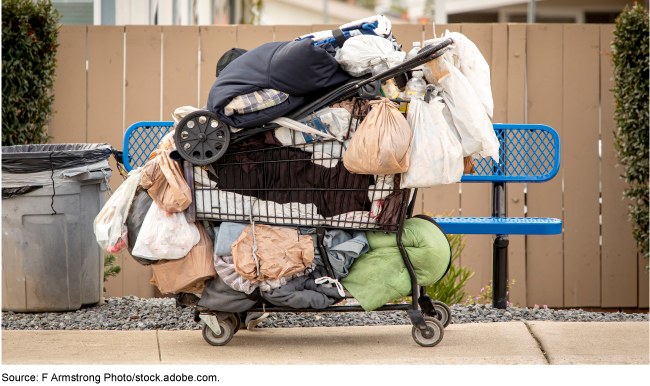Homelessness: Actions to Help Better Address Older Adults' Housing and Health Needs
Fast Facts
An estimated 138,000 older adults experienced homelessness on a single night in 2023.
We interviewed service providers and other stakeholders, and older adults (aged 55 and up) who had experienced homelessness.
Providers said finding affordable housing with accessibility features such as grab bars was particularly difficult. Similarly, older adults may need hard-to-find services such as home health care once in housing.
More clearly defined goals and measurements of progress could improve federal agencies' collaborative efforts to meet the needs of older adults experiencing homelessness. Our recommendations address this issue.

Highlights
What GAO Found
About 138,000 older adults (aged 55 and older) experienced homelessness on a single night in 2023, according to Department of Housing and Urban Development estimates. These adults often have needs that can be particularly challenging to address, according to 45 homelessness service providers and other stakeholders GAO spoke with.
- Housing needs. In addition to affordable housing, older adults often need housing with accessibility features. Providers described challenges finding accessible housing within the already limited supply of affordable housing.
- Health needs. Older adults often have mobility limitations, functional impairments (e.g., incontinence), or chronic conditions. These can be challenging to address in shelters, such as those with bunk beds or bathrooms with limited accessibility features (see figure). Some shelters GAO visited modified their spaces or services to accommodate these needs, while others cited resource constraints. Additionally, older adults transitioning into housing may need home and community-based services, such as home health care and personal care. Providers described challenges connecting older adults to such services, such as limited availability of providers.
Examples of Shelter Spaces with Limited Accessibility

Some stakeholders also said older adults belonging to certain racial, ethnic, or other groups can encounter additional barriers when accessing homelessness assistance programs. For example, they said members of some racial or ethnic groups may experience unfair treatment, an unwelcoming environment, or cultural insensitivity. Some providers reported taking steps to promote more equitable provision of services in their programs.
Some agencies have taken steps to address the needs of older adults experiencing homelessness, but collaboration practices of a key effort could be enhanced. Specifically, the interagency Housing and Services Resource Center, led by the Department of Health and Human Services, provides information and technical assistance on the housing and health needs of older adults experiencing homelessness. The center has generally incorporated six of GAO's eight leading practices for effective interagency collaboration. However, it has not yet clearly defined short- and long-term outcomes or collected and used related performance information to assess progress. Doing so would better ensure that the center is achieving its goals.
Why GAO Did This Study
High levels of homelessness, the aging U.S. population, and rising housing costs have raised concerns among researchers that a growing number of older adults could experience homelessness.
GAO was asked to review homelessness among older adults. This report examines the needs of older adults experiencing homelessness and barriers to addressing those needs. It also examines federal actions to address older-adult homelessness.
In nine communities selected for diversity of geography and population density, GAO conducted nongeneralizable interviews with 45 service providers and other stakeholders and 34 older adults with experiences of homelessness. In addition, GAO reviewed agency documents and interviewed federal agency officials.
Recommendations
GAO is making two recommendations to the Department of Health and Human Services for the Housing and Services Resources Center to (1) clearly define outcomes and (2) collect and use related performance information to assess progress. The Department of Health and Human Services concurred with the recommendations.
Recommendations for Executive Action
| Agency Affected | Recommendation | Status |
|---|---|---|
| Department of Health and Human Services | The Secretary of HHS should ensure that the ACL Administrator, as the lead agency for the Housing and Services Resource Center, works with partner agencies to clearly define short- and long-term outcomes for the center, consistent with leading collaboration practices. (Recommendation 1) |
HHS agreed with our recommendation and described general actions the Administration for Community Living planned to address it. As of January 2025, HHS did not provide timeframes for completing these actions. We will continue to monitor the progress HHS makes in implementing this recommendation.
|
| Department of Health and Human Services | The Secretary of HHS should ensure that the ACL Administrator, as the lead agency for the Housing and Services Resource Center, works with partner agencies to collect and use performance information and other relevant evidence to assess progress toward the center's desired outcomes, consistent with leading collaboration practices. (Recommendation 2) |
HHS agreed with our recommendation and described general actions the Administration for Community Living planned to address it. As of January 2025, HHS did not provide timeframes for completing these actions. We will continue to monitor the progress HHS makes in implementing this recommendation.
|
